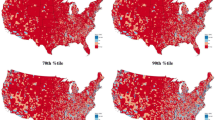ABSTRACT
The purpose of this paper is to build a predictive model of enrollment that provides data driven analysis to improve undergraduate recruitment efforts. We utilize an inquiry model, which examines the enrollment decisions of students that have made contact with our institution, a medium sized, public, Doctoral I university. A student, who makes an inquiry to our university such as by returning a request for information form, often provides far less information than is available from applicants. Despite this fact we find that characteristics of the student, as well as geographic and demographic data based on the student’s zip code are significant predictors of enrollment. Accounting for uncertainty in our model’s specification, we find that we are able to predict out of sample the enrollment decision of 89% of student inquiries. We also demonstrate how these findings can be used to improve marketing efforts.
Similar content being viewed by others
REFERENCES
Becker G. S. (1993). Human Capital: A Theoretical and Empirical Analysis With Special Reference to Education. University of Chicago Press, Chicago
Bruggink T. H., Gambhir V. (1996). Statistical models for college admission and enrollment: A case study for a selective liberal arts college. Research in Higher Education 37(2):221–240
Ceballo R., McLoyd V. C., Toyokawa T. (2004). The influences of neighborhood quality on adolescents’ educational values and school effort. Journal of Adolescent Research 19(6): 716–739
Davis-Van Atta D. L., Carrier S. C. (1986). Using the institutional research office. In: Hossler D. (eds) Managing College Enrollments. New Directions for Higher Education No 53, Jossey-Bass, San Francisco
Datcher L. (1982). Effects of community and family background on achievement. Review of Economics and Statistics 64(1):32–41
DesJardins S. L. (2002). An analytic strategy to assist institutional recruitment and marketing efforts. Research in Higher Education 43(5): 531–553
DesJardins S. L., Dundar H., Hendel D. D. (1999). Modeling the college application decision process in a land-grant university. Economics of Education Review 18(1): 117–132
Duncan G. J. (1994). Families and neighbors as sources of disadvantage in the schooling decisions of white and black-adolescents. American Journal of Education 103(1): 20–53
Garner C. L., Raudenbush S. W. (1991). Neighborhood effects on educational attainment – A multilevel analysis. Sociology of Education 64(4): 251–262
Goenner C. F., Snaith S. M. (2004). Accounting for model uncertainty in the prediction of university graduation rates. Research in Higher Education. 45(1): 25–41
Greene W. H. (1997). Econometric Analysis. Prentice Hall, Upper Saddle River, NJ
Hoeting J. A., Madigan D., Raftery A. E., Volinsky C. T. (1999). Bayesian model averaging: A tutorial. Statistical Science 14(4):382–401
Hosmer David W., Lemeshow S. (1989). Applied Logistic Regression. Wiley, New York
Hossler D., Gallagher K.S. (1987). Studying student college choice: A three phase model and the implications for policymakers. College and University 62(3): 207–221
Ihlanfeldt W. (1980). Achieving Optimal Enrollments and Tuition Revenues: A Guide to Modern Methods of Market Research, Student Recruitment, and Institutional Pricing. Jossey-Bass, San Francisco
Lang R. E., Hughes J. W., Danielson K. A. (1997). Targeting the suburban urbanites: marketing central-city housing. Housing Policy Debate 8(2): 437–470
Leppel K. (1993). Logit estimation of a gravity model of the college enrollment decision. Research in Higher Education 34(4): 387–398
Leventhal T., Brooks-Gunn J. (2000). The neighborhoods they live in: The effects of neighborhood residence on child and adolescent outcomes. Psychological Bulletin 126(2): 309–337
Manski C. F., Wise A. D. (1983). College Choice in America. Harvard University Press, Cambridge, MA
Paulsen, M. B. (1990). College Choice: Understanding Student Enrollment Behavior ASHE-ERIC Higher Education Report No. 6. Washington, D.C.: The George Washington University, School of Education and Human Development
Raftery A. E. (1995). Bayesian Model Selection in social research. In: Marsden P. V. (ed.), Sociological Methodology 1995. Blackwells Publishers, Cambridge, MA, pp. 111–163
Raftery A. E. (1997). Bayesian model averaging for linear regression models. Journal of the American Statistical Association, 92(437): 179–191
Raftery, A. E., and Volinsky C. T. (1996). Splus function Biclogit, version 2.0. (http://www.research.att.com/∼volinsky/bma.html)
Schwarz G. (1978). Estimating the dimension of a model. The Annals of Statistics 6: 461–464
Thomas E., Dawes W., Reznik G. (2001). Using predictive modeling to target student recruitment: Theory and practice. AIR Professional File 78(Winter): 1–8
Toutkoushian R. K. (2001). Do parental income and education attainment affect the initial choices of New Hampshire’s college-bound students?. Economics of Education Review 20(3): 245–262
Weiler W. C. (1994). Transition from consideration of a college to the decision to apply. Research in Higher Education 35(6): 631–646
Author information
Authors and Affiliations
Corresponding author
Rights and permissions
About this article
Cite this article
Goenner, C.F., Pauls, K. A Predictive Model of Inquiry to Enrollment. Res High Educ 47, 935–956 (2006). https://doi.org/10.1007/s11162-006-9021-8
Received:
Accepted:
Published:
Issue Date:
DOI: https://doi.org/10.1007/s11162-006-9021-8




